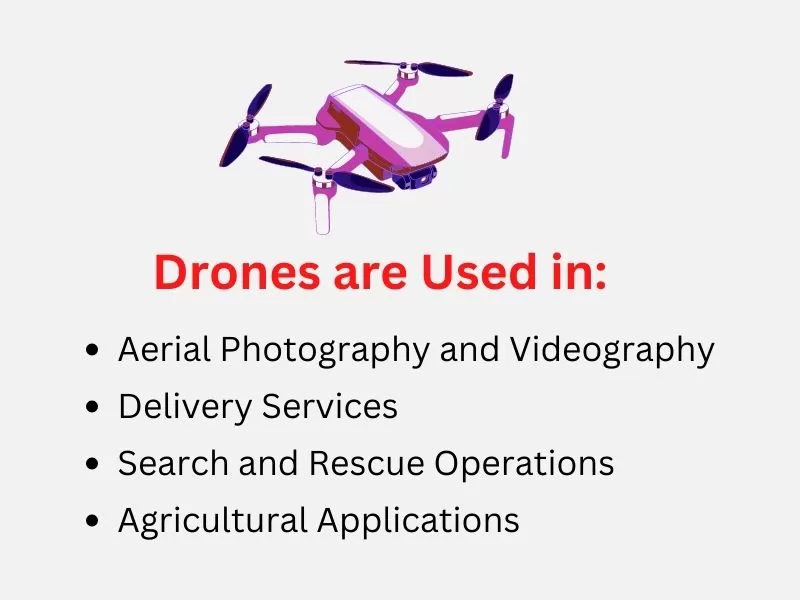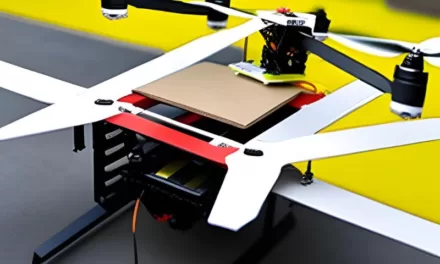Prepare to be amazed as we lift the veil on the awe-inspiring realm of the future of drones.
Current Uses of Drones | Autonomous Drones | Urban Air Mobility | Environmental Applications | Medical and Healthcare | Future Innovations and Trends
Imagine capturing sweeping aerial vistas with a bird’s-eye view, immortalizing precious moments in stunning aerial photography and videography. Now, envision a future where drones go beyond visual artistry and become an integral part of our daily lives, revolutionizing industries and transforming the way we experience the world.
Picture a world where urgent aid swiftly reaches those in distress, where lives are saved through swift and precise search and rescue operations. Envision the agricultural landscape, where drones contribute to sustainable practices, optimizing resources and monitoring crop health in agricultural applications. Visualize a future where our skies are filled with autonomous drones, seamlessly navigating urban environments, and transforming the concept of transportation with urban air mobility.
Embark on a journey with us as we uncover the endless possibilities of the future of drones. Explore their remarkable potential in delivery services, where packages are whisked through the skies, reaching your doorstep in record time. Delve into the realm of environmental applications, where drones aid in wildlife conservation, monitor air quality, and contribute to a greener future. Discover how drones are revolutionizing the field of medical and healthcare innovations, delivering crucial supplies to remote locations and assisting in emergency response efforts.
Let’s Talk about Future of Drones!
While the future of drones is filled with promise, it’s essential to address the challenges and concerns that accompany their rapid advancement. From safety and security considerations to privacy and regulatory frameworks, we navigate the complexities of this evolving technology.
Join us as we unveil the future innovations and trends that will shape the drone landscape, from extended flight durations to enhanced battery technology and integration with emerging technologies like 5G and the Internet of Things (IoT).
Introduction
Drones have rapidly emerged as an integral part of our modern world, revolutionizing various industries and capturing the imagination of people worldwide. With remarkable advancements in drone technology, we find ourselves at the forefront of an era where the potential applications of drones seem boundless. In this article, we will explore the exciting future of drones and how they are reshaping our world.
Current Uses of Drones

Aerial Photography and Videography:
Drones have become an indispensable tool for capturing breathtaking aerial footage and imagery. From filmmakers and photographers to content creators and real estate agents, the use of drones in capturing stunning visuals has become more accessible and cost-effective. With their agility and high-resolution cameras, drones enable professionals and enthusiasts alike to capture unique perspectives and produce captivating content.
Delivery Services:
The future of delivery services lies in the skies. Companies like Amazon and UPS are already experimenting with drone delivery, aiming to revolutionize logistics by efficiently transporting packages over short distances. Drones equipped with advanced navigation systems can swiftly navigate urban landscapes, delivering goods with greater speed and reducing congestion on the ground.
Search and Rescue Operations:
Drones equipped with thermal imaging and high-resolution cameras have proven to be invaluable in search and rescue missions. They can quickly cover large areas, locate missing individuals, and provide real-time situational awareness to rescue teams. By enhancing search capabilities and reducing response times, drones are saving lives and making rescue operations more efficient.
Agricultural Applications:
Drones have the potential to revolutionize the agricultural industry. Equipped with multispectral sensors and imaging systems, they can monitor crop health, detect pests and diseases, and optimize irrigation and fertilization processes. By providing farmers with detailed data and actionable insights, drones enable precision agriculture, leading to improved yields and reduced environmental impact.
Autonomous Drones:
Artificial Intelligence Integration: Future of Drones
The integration of artificial intelligence (AI) into drone systems opens up new possibilities. AI algorithms can enable drones to analyze data in real-time, make autonomous decisions, and adapt to changing environments. This capability enhances their ability to perform complex tasks, such as object detection, tracking, and obstacle avoidance, making them more efficient and safe.
Enhanced Navigation Systems: Future of Drones
Advancements in navigation systems, including GPS and advanced sensors, enable drones to navigate with greater precision and autonomy. Waypoint navigation allows drones to follow predetermined routes, while obstacle detection and avoidance systems ensure safe and reliable operations. These advancements are crucial for expanding the scope of drone applications, from delivery services to urban air mobility.
Swarm Technology: Future of Drones
Swarm technology involves the coordination of multiple drones working together towards a common goal. By leveraging collective intelligence and communication protocols, drone swarms can perform tasks that are beyond the capabilities of individual drones. This technology holds immense potential in areas such as search and rescue, disaster response, and infrastructure inspections.
Urban Air Mobility: Future of Drones
Introduction to Urban Air Mobility
Urban air mobility envisions a future where drones and other electric aircraft provide on-demand transportation within cities. This concept introduces flying taxis and personal transport options, reducing traffic congestion and offering faster, more convenient travel. Vertical takeoff and landing capabilities make drones ideal for urban air mobility, and ongoing research and development are paving the way for this futuristic transportation system.
Flying Taxis and Personal Transport: Future of Drones
Imagine a world where commuting via drones becomes a reality. Flying taxis, capable of carrying passengers from one point to another in crowded cities, offer an innovative solution to urban congestion. With electric propulsion systems and advanced navigation technologies, these autonomous aircraft promise a future where our daily commutes are transformed into seamless airborne experiences.
Traffic Management Systems: Future of Drones
As the number of drones in urban airspace increases, efficient traffic management becomes crucial. Traffic management systems designed specifically for drones ensure safe and coordinated operations. These systems rely on real-time data, sophisticated algorithms, and communication protocols to manage flight routes, monitor airspace congestion, and prevent collisions.
Infrastructure Development
The integration of drones into urban airspace requires dedicated infrastructure development. This includes landing pads, charging stations, and maintenance facilities. Cities and authorities need to plan and invest in the infrastructure required to support the widespread use of drones for urban air mobility. By doing so, they can unlock the full potential of this transformative transportation system.
Environmental Applications: Future of Drones
Wildlife Conservation and Monitoring
Drones have proven to be invaluable tools in wildlife conservation efforts. They can monitor and survey endangered species, detect illegal activities like poaching, and track animal movements. The ability to access remote areas and collect data non-invasively makes drones an essential asset for conservationists, aiding in the protection of our planet’s precious biodiversity.
Air Quality Monitoring
Monitoring air quality is crucial for understanding and mitigating environmental pollution. Drones equipped with specialized sensors can collect real-time data on air pollutants, enabling accurate mapping of pollution sources and assisting in the development of effective mitigation strategies. By providing precise and up-to-date information, drones contribute to the improvement of air quality and public health.
Precision Farming: Future of Drones
The future of agriculture lies in precision farming, and drones play a significant role in this transformation. They can collect data on soil conditions, monitor crop health, and optimize resource allocation. By providing farmers with actionable insights, drones enable precise application of fertilizers, pesticides, and irrigation, leading to improved yields, reduced environmental impact, and sustainable agricultural practices.
Disaster Management: Future of Drones
During natural disasters, drones can be deployed to assess damages, identify survivors, and support relief operations. Equipped with thermal imaging cameras and high-definition video capabilities, they provide real-time situational awareness, aiding emergency responders in making informed decisions. Drones significantly enhance disaster management by improving response times and facilitating effective coordination.
Medical and Healthcare Innovations: Future of Drones
Drone Delivery of Medical Supplies
In remote areas or during emergencies, accessing medical supplies can be a matter of life and death. Drones equipped with medical payloads can swiftly transport essential medicines, vaccines, and equipment to locations that are otherwise challenging to reach. By reducing delivery times and expanding access to critical healthcare resources, drones have the potential to save lives and improve medical outcomes.
Emergency Medical Response: Future of Drones
Drones equipped with medical equipment and communication systems can play a vital role in emergency medical response. They can provide immediate medical assistance, such as delivering defibrillators or first aid kits, to patients in remote locations. These aerial responders can bridge the gap between emergency situations and the arrival of traditional medical personnel, ultimately increasing the chances of survival.
Remote Healthcare Access
In areas with limited access to healthcare facilities, drones can act as a bridge, bringing medical expertise to remote communities. With telemedicine capabilities, doctors can remotely assess patients and provide guidance in real-time. Drones equipped with medical devices and video conferencing tools enable remote consultations, ensuring timely and accessible healthcare services.
Challenges and Concerns: Future of Drones
Safety and Security
As drones become more prevalent, ensuring their safe and secure operations is paramount. Safety measures such as collision-avoidance systems, geofencing, and strict regulations are essential to prevent accidents and protect both people and property. Additionally, addressing security concerns, such as unauthorized drone usage and potential misuse of drone technology, requires ongoing vigilance and robust countermeasures.
Privacy Concerns
The widespread use of drones raises legitimate privacy concerns. The ability of drones to capture high-resolution images and videos raises questions about the protection of personal privacy. Striking a balance between the benefits of drone technology and respecting individuals’ privacy rights requires clear guidelines and regulations governing drone usage and data collection.
Regulatory Frameworks: Future of Drones
To ensure the safe integration of drones into society, robust regulatory frameworks are necessary. Governments and aviation authorities must establish guidelines and regulations that govern drone operations, including flight restrictions, licensing requirements, and privacy protection measures. By developing comprehensive frameworks, policymakers can enable the responsible and beneficial use of drones.
Future Innovations and Trends: Future of Drones
Longer Flight Durations
One area of ongoing development is extending the flight duration of drones. Innovations in battery technology, including higher energy densities and improved charging methods, are allowing drones to stay airborne for longer periods. Longer flight durations enable drones to cover larger areas, perform more complex tasks, and support extended operations, further expanding their potential applications.
Improved Battery Technology: Future of Drones
Battery technology is a critical factor in drone performance and longevity. Ongoing research aims to develop batteries that offer increased energy storage capacity, faster charging times, and enhanced safety features. Advances in battery technology will not only extend flight durations but also improve overall drone efficiency, reliability, and user experience.
Advanced Sensors and Imaging Systems: Future of Drones
Advancements in sensor technology continue to enhance the capabilities of drones. Higher-resolution cameras, multispectral sensors, and LiDAR systems enable drones to capture detailed data with greater accuracy. These sensors, coupled with sophisticated image processing algorithms, provide drones with enhanced capabilities for mapping, monitoring, and data analysis.
Integration with 5G and Internet of Things (IoT)
The integration of drones with 5G networks and the Internet of Things (IoT) opens up new possibilities. With the high-speed, low-latency connectivity offered by 5G, drones can transmit data in real-time, enabling seamless communication and remote control. Integration with the IoT allows drones to interact with other connected devices and systems, facilitating collaborative operations and expanding their potential applications.
Conclusion
The future of drones is brimming with possibilities. From their current uses in aerial photography and delivery services to their potential in urban air mobility, environmental applications, and healthcare innovations, drones are reshaping industries and transforming the way we live. While challenges and concerns exist, addressing safety, privacy, and regulatory aspects will pave the way for a future where drones become integral to our daily lives. By embracing the opportunities ahead, we can harness the power of drones to create a more connected, efficient, and sustainable world.


